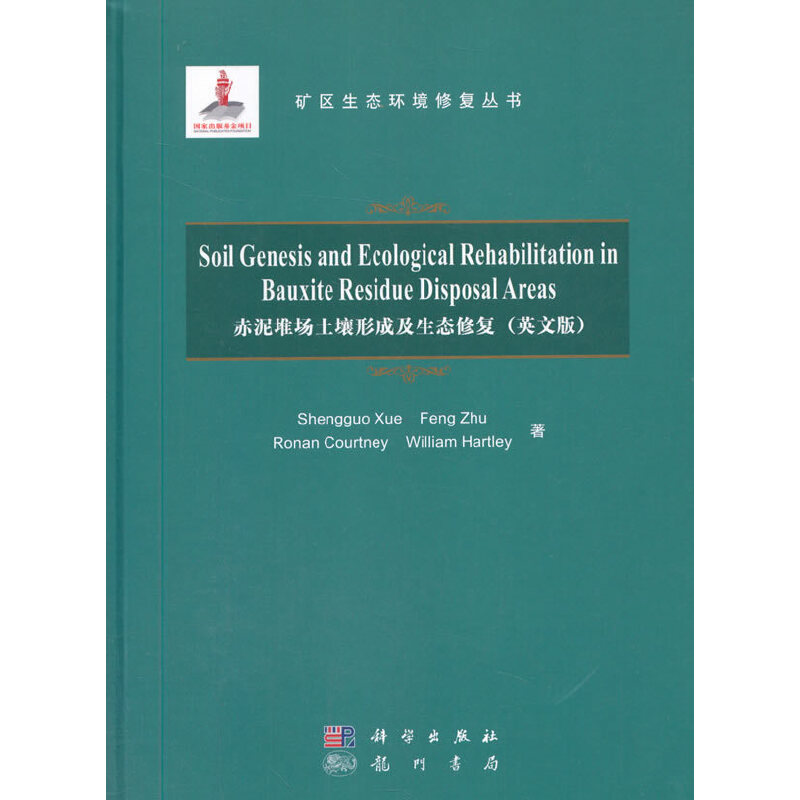
赤泥堆场土壤形成及生态修复(英文版)

- ISBN:9787508857800
- 装帧:平装-胶订
- 册数:暂无
- 重量:暂无
- 开本:16开
- 页数:316
- 出版时间:2020-10-01
- 条形码:9787508857800 ; 978-7-5088-5780-0
内容简介
Ecological rehabilitation is the most effective strategy to remediate bauxite residue on a large scale. To improve this process, soil genesis is considered a key process to support plant establishment. This book systematically introduces the latest research on bauxite residue characteristics, soil genesis, saline-alkali regulation, aggregate formation, environmental risk, including several case studies of ecological rehabilitation on bauxite residue disposal areas. This book will provide scientific reference for the alumina industry and researchers working on the restoration of large-scale bauxite disposal areas and enhance theoretical research on the disposal of large industrial solid waste worldwide.This book can be used as a reference for experts, scholars, technicians, managers and graduate students from the fields of environment, ecology and biology.
目录
Chapter 1 Characterization and Disposal of Bauxite Residue 1
1.1 Introduction 1
1.2 Generation of Bauxite Residue 3
1.2.1 Bauxite Production and Global Reserves 3
1.2.2 Production Process of Alumina 4
1.2.3 Annual Production and Inventory of Bauxite Residue 6
1.3 Properties of Bauxite Residue 6
1.3.1 Physical Properties 6
1.3.2 Chemical Properties 7
1.3.3 Biological Properties 13
1.4 Management of Bauxite Residue 14
1.4.1 Conventional Disposal of Bauxite Residue 14
1.4.2 Utilization of Bauxite Residue 14
1.5 Alkalinity Transformation of Bauxite Residue 15
1.5.1 Alkaline Solid Transformation 15
1.5.2 Waste Acid Synergy 20
1.5.3 Acid Gas Sequestration 21
1.5.4 Chloride Salt Neutralization 24
1.6 Soil Formation and Revegetation of Bauxite Residue 26
1.6.1 Amelioration of Bauxite Residue 27
1.6.2 Screening of Tolerant Plant Species and Microorganisms 28
1.6.3 Soil Formation in Bauxite Residue 30
References 31
Chapter 2 Novel Predictors of Soil Genesis in Bauxite Residue under Natural Weathering Processes 38
2.1 Natural Evolution of Alkaline Characteristics in Bauxite Residue 38
2.1.1 Transformation of Basic Alkalinity 40
2.1.2 Transformation of Electrical Conductivity 42
2.1.3 Transformation of Exchangeable Cations 43
2.1.4 Transformation of Acid Neutralizing Capacity 45
2.1.5 Environmental Management for Long-Term Disposal 47
2.2 Natural Plant Colonization Improves Physical Conditions of Bauxite Residue 47
2.2.1 Particle Size Distribution 48
2.2.2 Bulk Density and Total Porosity 50
2.2.3 Mean Weight Diameter (MWD) and Water-Stable Aggregates (WSA) 51
2.2.4 Structural Stability Index (SI) 52
2.3 Development of Alkaline Electrochemical Characteristics 52
2.3.1 Mineralogy 53
2.3.2 Zeta Potential Curves and Isoelectric Point 56
2.3.3 Surface Protonation and Alkaline Group 58
2.4 Dynamic Development of Bacterial Community Diversity and Structure 60
2.4.1 Residue Properties 61
2.4.2 Diversity of Bacterial Community 62
2.4.3 Composition of Bacterial Community 63
2.4.4 Correlation between Bacterial Community and Residue Property 67
2.5 Novel Predictors of Soil Genesis in Bauxite Residue 69
2.5.1 Variation of Chemical Properties 70
2.5.2 Variation of Physical Properties 72
2.5.3 Effects on Aggregate Stability 73
2.5.4 Novel Predictors of Soil Genesis 76
References 78
Chapter 3 Aggregate Formation and Stability in Bauxite Residue Following Soil Genesis 87
3.1 Erosion Resistance of Water-Stable Aggregates in Bauxite Residue 87
3.1.1 Distribution of Aggregate Fractions and MWD by the Modified Yoder’s Method 87
3.1.2 Distribution of Aggregate Fractions and MWD by the Modified Le Bissonnais,Method 89
3.1.3 The Erodibility Factor (K) of Bauxite Residues 91
3.1.4 Variable Effectiveness of Mechanisms to Erosion of Bauxite Residue 93
3.2 Effects of Iron-Aluminum Oxides and Organic Carbon on Aggregate Stability 95
3.2.1 Iron-Aluminiim Oxide Contents and Their Relationship with Aggregate Stability 95
3.2.2 Aggregate-Associated Carbon and the Relationship with Aggregate Stability 97
3.2.3 Variation of Aggregate-Associated Organic Carbon Functional Groups 99
3.3 Fractal Features of Residue Microaggregates in Bauxite Residue Disposal Areas 101
3.3.1 Particle Size Distribution of Residue Microaggregates 102
3.3.2 Microaggregate Stability of the Residues 105
3.3.3 Single-Fractal Features of Residue Microaggregates 109
3.3.4 Multi-Fractal Dimension of Residue Microaggregates Ill
3.3.5 Relationship between Microaggregate Stability and Fractal Parameters 114
3.4 Effects of Binding Materials on Micro-Aggregate Size Distribution in Bauxite Residues 115
3.4.1 Effect of Organic Matter 115
3.4.2 Effect of Carbonate on Residue Microaggregate Size Distribution 117
3.4.3 Effect of Electrolyte on Residue Microaggregate Size Distribution 118
3.4.4 Effect of Clay Mineralogy on Residue Microaggregate Size Distribution 120
3.4.5 Effect of Iron-Aluminum Oxides on Residue Microaggregate Size Distribution 121
3.5 Evaluation on Aggregate Microstructures Following Natural Regeneration 122
3.5.1 Residue Micromorphology 122
3.5.2 Visualization of Soil Aggregates 126
3.5.3 Porosity and Pore-Size Distribution 127
3.5.4 Shape Parameters in Residue Aggregates 128
3.5.5 Effects on Residue Aggregate Microstructure 130
3.6 Vermicompost and Gypsum Improve Aggregate Formation in Bauxite Residue 131
3.6.1 Residue Properties 132
3.6.2 Residue Macroaggregate Formation 134
3.6.3 Residue Microaggregate Formation 137
3.6.4 Residue Micromorphology 139
References 141
Chapter 4 Regulation on Saltinity and Alkalinity of Bauxite Residue Following Soil Genesis 149
4.1 Migration and Distribution of Saline Ions in Bauxite Residue during Water Leaching 149
4.1.1 Change of Saline Cation Concentration in Leachate 150
-

黑科技驱动世界的100项技术
¥20.9¥69.8 -

船舶综合驾驶台通信与导航系统:::
¥41.8¥58.0 -

西门子S7-1200 PLC项目化教程
¥43.7¥54.0 -

宽带数字接收机技术(第三版)
¥76.5¥139.0 -

房树人绘画投射测验——临床应用实践手册
¥62.4¥78.0 -

工业与民用供配电设计手册-(上.下册)-第四版
¥248.3¥388.0 -

工业聚乙烯导论
¥73.5¥98.0 -

(教材)产业用纺织品实验教程
¥41.8¥58.0 -

变电二次安装工实用技术
¥75.5¥128.0 -

作战无人机系统和全球作战无人机
¥141.4¥186.0 -

机床维修电工(第3版)
¥23.4¥39.0 -

从模仿到创新:苏联液体弹道火箭技术的发展1944-1951
¥55.4¥88.0 -

熔喷非织造成形理论
¥56.4¥99.0 -

《煤矿地质工作细则》释义
¥27.4¥48.0 -

二战信息图 数据化全景透视第二次世界大战
¥163.5¥268.0 -

生命教育丛书:防灾避难与危机处理
¥14.9¥49.8 -

产业用纺织品实验教程
¥53.0¥78.0 -

复合材料数字化研制与工程实战
¥124.6¥178.0 -

UG NX 后处理技术与应用案例
¥77.4¥119.0 -

指挥员关键信息需求研究
¥48.0¥80.0










